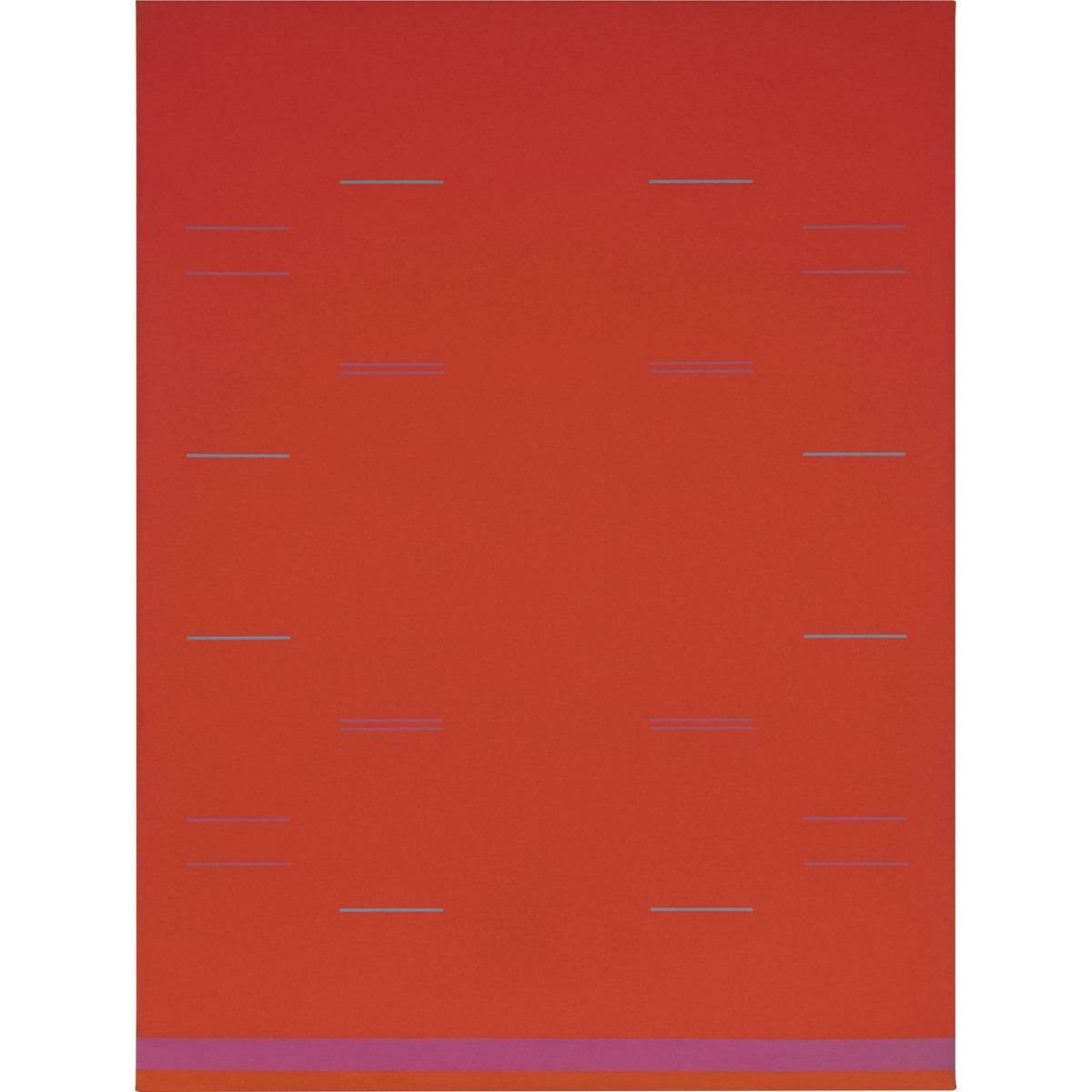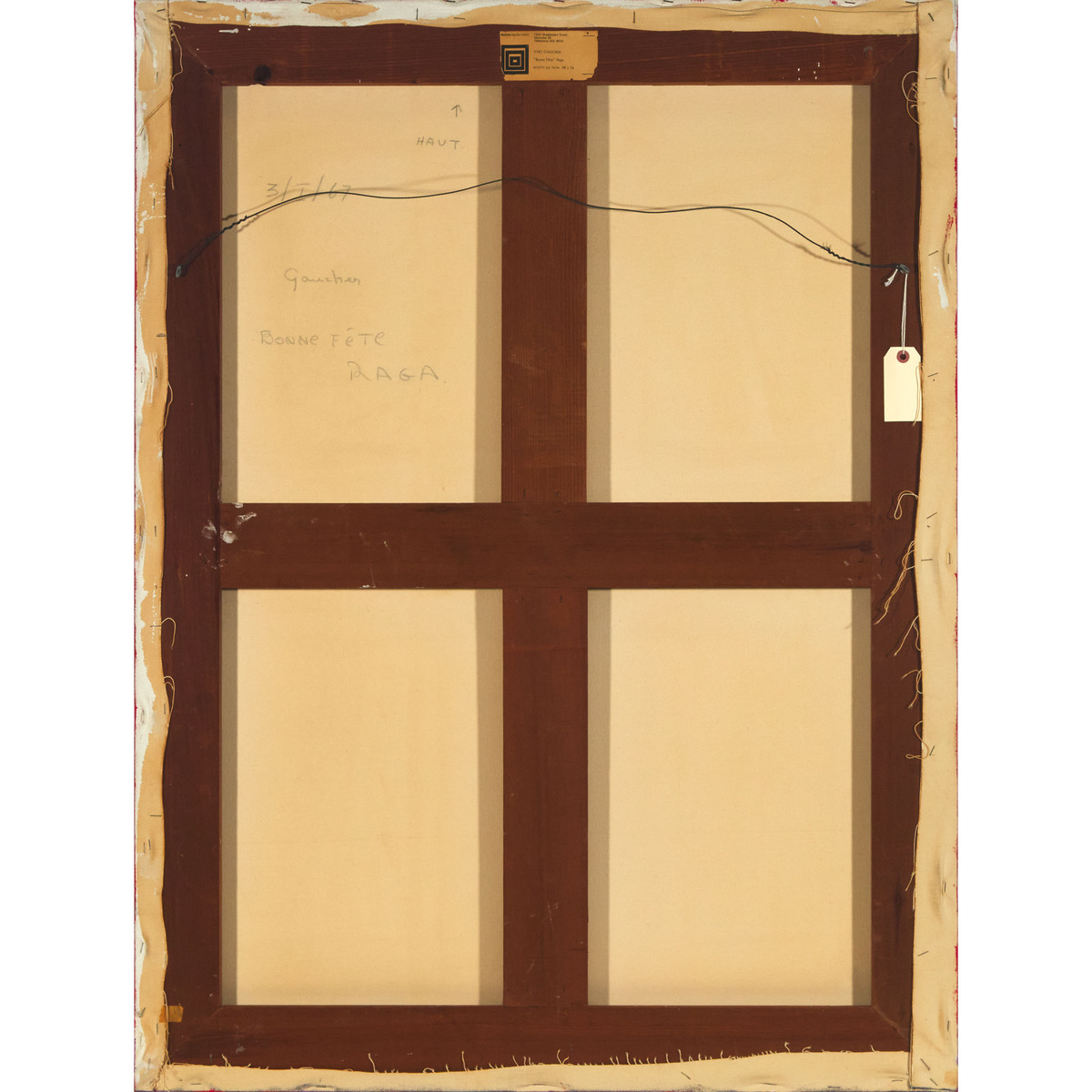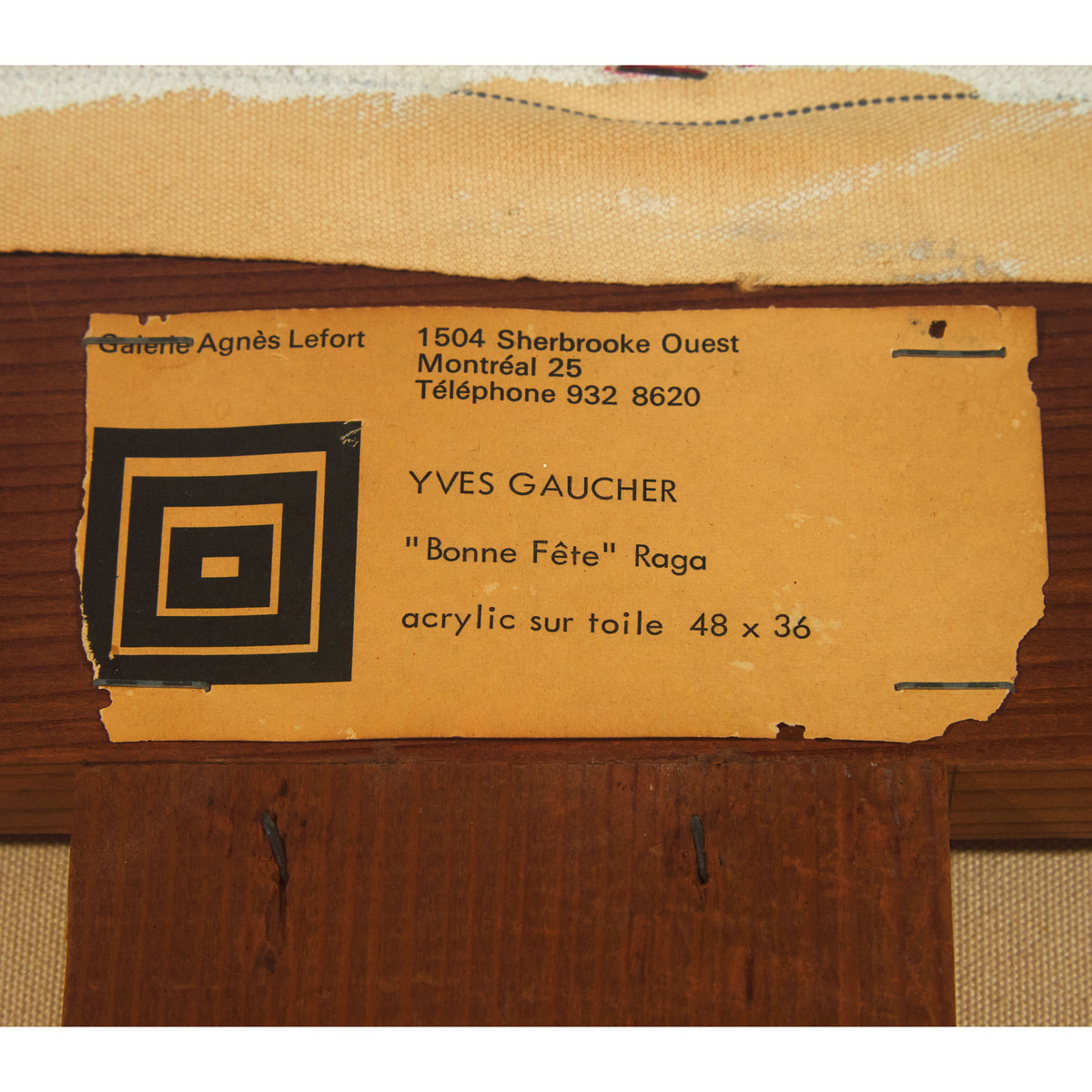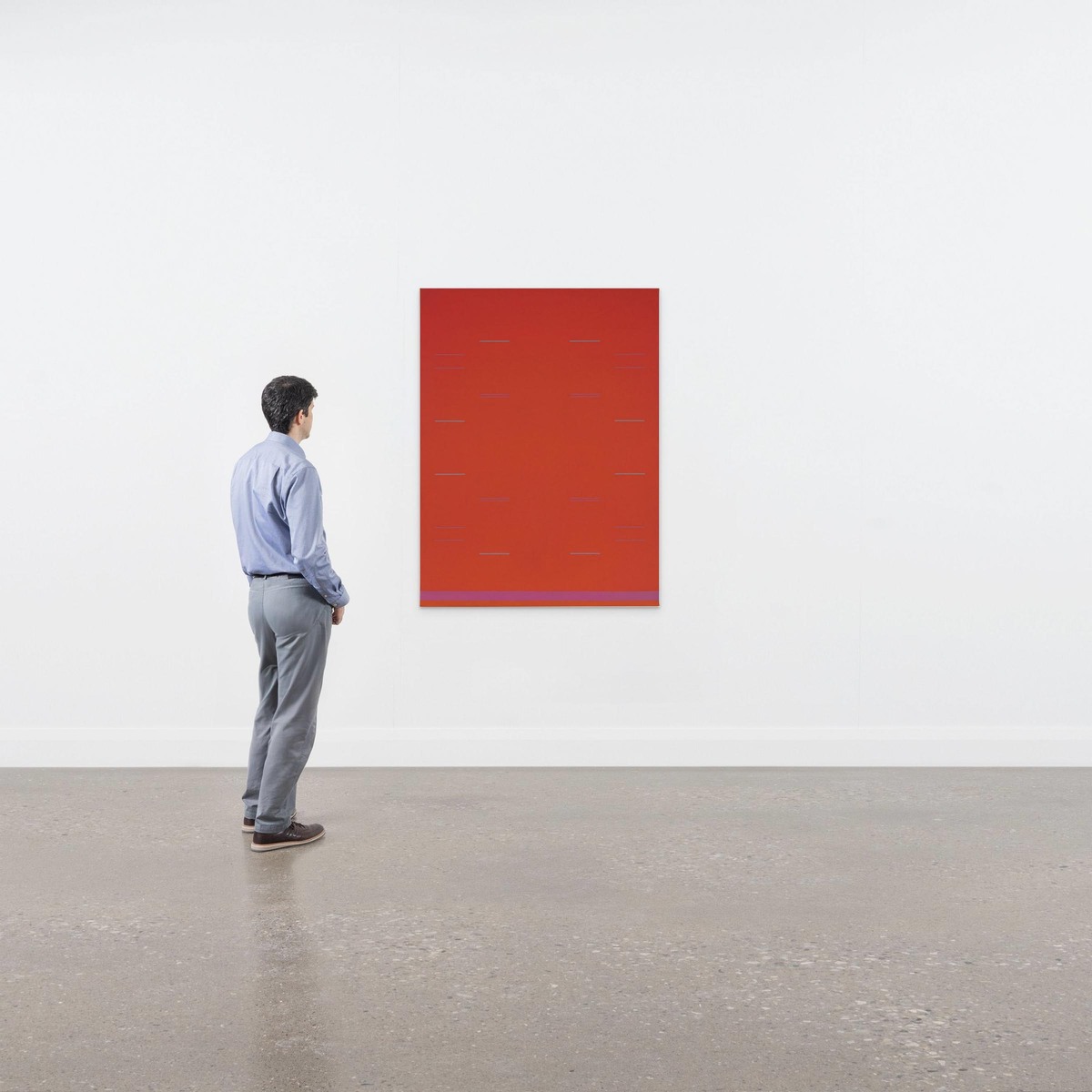38
Yves Gaucher, RCA (1934-2000), BONNE FÊTE, RAGA, 1967, 48 x 36 in — 121.9 x 91.4 cm
BONNE FÊTE, RAGA, 1967
acrylic on canvas
signed, dated "3 / I / 67", and titled verso; also titled to gallery label verso
48 x 36 in — 121.9 x 91.4 cm
Provenance:
Galerie Agnès Lefort, Montreal, QC
Private Collection, Montreal, QC
Exhibited:
Yves Gaucher, Galerie Agnès Lefort, Montreal, QC, 6-19 May 1967.
Literature:
Manon Gaulin, The Arts: Toward Serenity, Time (Canadian edition), 26 May 1967, 9 repro. col. as Happy Birthday Raga.
William James Gordon Kirby, A Discussion of Five Canadian Painters - Ronald Bloore, Brian Fisher, Yves Gaucher, Roy Kiyooka, Arthur McKay - in the Context of the Artistic and Critical Sensibility of the 1960's, MA diss., (University of British Columbia, 1973) 29, as Happy Birthday Raga.
Martine Perreault, Repères chronologiques, and Chronology, in Yves Gaucher (exh. cat.) (Montreal, QC: Musée d'art contemporain, 2003), 139 and 236, as Bonne fête raga and Happy Birthday Raga (respectively).
Note:
Bonne fête, Raga earned a colour reproduction in Time magazine when it was first shown in Yves Gaucher’s 1967 solo exhibition at Galerie Agnès Lefort in Montreal. The Time review was titled Towards Serenity.[1] When the art critic Carol Zemel, writing for Artscanada, visited the show, someone, surely the artist himself, submitted her to a little lightshow. First she looked at the paintings under the normal gallery lighting. Then the lights were lowered, and, as she discovered, now when each painting was differently lit, not only did it look different, but in its new state it totally held its own, in Zemel’s judgement, as “a complete statement.”[2]
With Bonne fête, Raga we can ourselves repeat the exercise. Observe first its dominant cadmium red ground, which spreads upwards and outwards with no upper or lateral restraints. Thin horizontal blue and purple stripes, or signals, as Gaucher called them, play jauntily across it, dispersed in a symmetrical oval formation above a thicker purple baseline. But it is the ground plane, more than ever before in Gaucher’s work, that sets the mood. And celebratory it is, as appropriate, as per its title, for a birthday greeting. The paint is perfectly smooth and edges are crisp and clean.
Then we dim the lights and the red plane ever so gently dematerializes, transforming itself from matter into light. The signals hover and seem to glow from within. It is like being transported from the outward world into an inner otherworld. As Gaucher wanted to demonstrate to Zemel, “I am not painting pictures; I am painting states of mind.” He wanted his paintings understood not as pictures of something, but as objects in their own right, plotted out so as to enrapture the viewer’s inner self.
This was no doubt also true of his earlier hardedge and optically active paintings from before the 1967 Agnès Lefort exhibition. But the Ragas, like Bonne fête, Raga, were an inflection point. With their evocative intensity, it is as if they announced Gaucher’s separation from his fellow Plasticiens, Guido Molinari and Claude Tousignant. If the latter’s concurrent work celebrated optical phenomena in the secular world, Gaucher instead was veering off to probe inner states of mind, even broaching the transcendent, a direction decisive for his future work.
But it was not so surprising a turn. Already in 1960, well before Yves Gaucher became a hard-edge colour painter, the critic Françoise de Repentigny had described his then work as transcendental, contemplative and spiritual.[3] And a transformative moment in his turning to pure abstraction was seeing a Mark Rothko exhibition in 1961 in New York, and then again in Paris in 1962. It was Rothko, as Gaucher later explained, who clarified for him what painting meant: “It’s not what you see… it's not what you analyze… but the state of trance that you could be put into by the work.”[4]
Note: the Raga titles reflect the passion that Gaucher had developed for Indian music during the 1960s. He had used other musical titles – the Hommage à Webern prints and the Danse Carrée paintings – and analogies suggest themselves between his compositional rhythms and musical sounds. But we should not overthink this. If the music sparked ideas, their realizations on paper or canvas followed their own visual imperatives.
[1] Manon Gaulin, Toward Serenity, Time, (Can. ed.), 26 May 1967, 9.
[2] Carol Zemel, Montreal spring ’67 in the galleries, Artscanada, xxxiv 6/7, 109-110.
[3] Françoise de Repentigny, La Relève? De qui, de quoi? Le Devoir, 26 fevrier, 1960.
[4] Cited in Roald Nasgaard, Yves Gaucher: A Fifteen-Year Perspective, 1963-1978 (Toronto: Art Gallery of Ontario, 1979), 41.
Roald Nasgaard is the author of the critically acclaimed "Abstract Painting in Canada" (2008). He has curated exhibitions and written extensively on the Montreal Automatistes and Plasticiens. Nasgaard’s monograph on Charles Gagnon will be published in Spring 2025.
Estimate: $25,000—35,000
BONNE FÊTE, RAGA, 1967
acrylic on canvas
signed, dated "3 / I / 67", and titled verso; also titled to gallery label verso
48 x 36 in — 121.9 x 91.4 cm
Provenance:
Galerie Agnès Lefort, Montreal, QC
Private Collection, Montreal, QC
Exhibited:
Yves Gaucher, Galerie Agnès Lefort, Montreal, QC, 6-19 May 1967.
Literature:
Manon Gaulin, The Arts: Toward Serenity, Time (Canadian edition), 26 May 1967, 9 repro. col. as Happy Birthday Raga.
William James Gordon Kirby, A Discussion of Five Canadian Painters - Ronald Bloore, Brian Fisher, Yves Gaucher, Roy Kiyooka, Arthur McKay - in the Context of the Artistic and Critical Sensibility of the 1960's, MA diss., (University of British Columbia, 1973) 29, as Happy Birthday Raga.
Martine Perreault, Repères chronologiques, and Chronology, in Yves Gaucher (exh. cat.) (Montreal, QC: Musée d'art contemporain, 2003), 139 and 236, as Bonne fête raga and Happy Birthday Raga (respectively).
Note:
Bonne fête, Raga earned a colour reproduction in Time magazine when it was first shown in Yves Gaucher’s 1967 solo exhibition at Galerie Agnès Lefort in Montreal. The Time review was titled Towards Serenity.[1] When the art critic Carol Zemel, writing for Artscanada, visited the show, someone, surely the artist himself, submitted her to a little lightshow. First she looked at the paintings under the normal gallery lighting. Then the lights were lowered, and, as she discovered, now when each painting was differently lit, not only did it look different, but in its new state it totally held its own, in Zemel’s judgement, as “a complete statement.”[2]
With Bonne fête, Raga we can ourselves repeat the exercise. Observe first its dominant cadmium red ground, which spreads upwards and outwards with no upper or lateral restraints. Thin horizontal blue and purple stripes, or signals, as Gaucher called them, play jauntily across it, dispersed in a symmetrical oval formation above a thicker purple baseline. But it is the ground plane, more than ever before in Gaucher’s work, that sets the mood. And celebratory it is, as appropriate, as per its title, for a birthday greeting. The paint is perfectly smooth and edges are crisp and clean.
Then we dim the lights and the red plane ever so gently dematerializes, transforming itself from matter into light. The signals hover and seem to glow from within. It is like being transported from the outward world into an inner otherworld. As Gaucher wanted to demonstrate to Zemel, “I am not painting pictures; I am painting states of mind.” He wanted his paintings understood not as pictures of something, but as objects in their own right, plotted out so as to enrapture the viewer’s inner self.
This was no doubt also true of his earlier hardedge and optically active paintings from before the 1967 Agnès Lefort exhibition. But the Ragas, like Bonne fête, Raga, were an inflection point. With their evocative intensity, it is as if they announced Gaucher’s separation from his fellow Plasticiens, Guido Molinari and Claude Tousignant. If the latter’s concurrent work celebrated optical phenomena in the secular world, Gaucher instead was veering off to probe inner states of mind, even broaching the transcendent, a direction decisive for his future work.
But it was not so surprising a turn. Already in 1960, well before Yves Gaucher became a hard-edge colour painter, the critic Françoise de Repentigny had described his then work as transcendental, contemplative and spiritual.[3] And a transformative moment in his turning to pure abstraction was seeing a Mark Rothko exhibition in 1961 in New York, and then again in Paris in 1962. It was Rothko, as Gaucher later explained, who clarified for him what painting meant: “It’s not what you see… it's not what you analyze… but the state of trance that you could be put into by the work.”[4]
Note: the Raga titles reflect the passion that Gaucher had developed for Indian music during the 1960s. He had used other musical titles – the Hommage à Webern prints and the Danse Carrée paintings – and analogies suggest themselves between his compositional rhythms and musical sounds. But we should not overthink this. If the music sparked ideas, their realizations on paper or canvas followed their own visual imperatives.
[1] Manon Gaulin, Toward Serenity, Time, (Can. ed.), 26 May 1967, 9.
[2] Carol Zemel, Montreal spring ’67 in the galleries, Artscanada, xxxiv 6/7, 109-110.
[3] Françoise de Repentigny, La Relève? De qui, de quoi? Le Devoir, 26 fevrier, 1960.
[4] Cited in Roald Nasgaard, Yves Gaucher: A Fifteen-Year Perspective, 1963-1978 (Toronto: Art Gallery of Ontario, 1979), 41.
Roald Nasgaard is the author of the critically acclaimed "Abstract Painting in Canada" (2008). He has curated exhibitions and written extensively on the Montreal Automatistes and Plasticiens. Nasgaard’s monograph on Charles Gagnon will be published in Spring 2025.
Estimate: $25,000—35,000
Canadian and International Fine Art
Ends from
Venue Address
For Waddington's delivery information please telephone +1 4165049100.
Important Information
Our spring offering of Canadian and International Fine Art brings together exceptional work from around the world. This auction features celebrated Canadian artists such as Cornelius Krieghoff, A.Y. Jackson, P.C. Sheppard, A.J. Casson, Bertram Booker, Alexandra Luke, Jean Paul Lemieux and Yves Gaucher as well as important First Nations artists Norval Morrisseau, Roy Thomas and Alex Janvier. International highlights include work by Jules Olitski, Karel Appel, Kwon Young-Woo, Norman Bluhm, Józef Bakoś, Léon Lhermitte and Montague Dawson.
Please contact us to find out more.
Terms & Conditions
1. Waddington's charges a buyer's premium of 25% on the hammer price up to and including
$25,000 CAD. Hammer price in excess of $25,000 CAD will be charged a buyer's premium of
22%.
Bidders buying on the Invaluable site will be charged a buyer's premium of 28% on the hammer
price up to and including $25,000 CAD. Hammer prices in excess of $25,000 CAD will be
charged at 25%.
2. Unless exempted by law, the buyer is required to pay Federal Good and Services Tax on the
total purchase price including the buyer’s premium.
3. The auctioneer reserves the right to withdraw any lot from sale at any time, to divide any lot
or to combine any two or more lots at his sole discretion, all without notice.
4. The auctioneer has the right to refuse any bid and to advance the bidding at his absolute
discretion. The auctioneer reserves the right not to accept and not to reject any bid. Without
limitation, any bid which is not commensurate with the value of the article offered, or which is
merely a nominal or fractional advance over the previous bid may not be recognized.
5. Each lot may be subject to an unpublished reserve which may be changed at any time by
agreement between the auctioneer and the consignor. The auctioneer may bid, or direct an
employee to bid, on behalf of the consignor as agreed between them. In addition, the auctioneer
may accept and submit absentee and telephone bids, to be executed by an employee of the
auctioneer, pursuant to the instructions of prospective purchasers not in attendance at the sale.
6. The highest bidder accepted by the auctioneer for any lot shall be the buyer and such buyer
shall forthwith assume full risk and responsibility for the lot and must comply with such other
Conditions of Sale as may be applicable. If any dispute should arise between bidders the
auctioneer shall have the absolute discretion to designate the buyer or, at his option, to
withdraw any disputed lot from the sale, or to re-offer it at the same or a subsequent sale. The
auctioneer’s decision in all cases shall be final.
7. Immediately after the purchase of a lot, the buyer shall pay or undertake to the satisfaction of
the auctioneer with respect to payment of the whole or any part of the purchase price requested
by the auctioneer, failing which the auctioneer in his sole discretion may cancel the sale, with or
without re-offering the item for sale.
8. The buyer shall pay for all lots within 48 hours from the date of the sale, after which a late
charge of 2% per month on the total invoice may be incurred or the auctioneer, in his sole
discretion, may cancel the sale. The buyer shall not become the owner of the lot until paid for in
full. Items must be removed within 10 days from the date of sale, after which storage charges
may be incurred.
9. Each lot purchased, unless the sale is cancelled as above, shall be held by the auctioneer at
his premises or at a public warehouse at the sole risk of the buyer until fully paid for and taken
away.
10. All lots are sold “AS IS”. Any description issued by the auctioneer of an article to be sold is
subject to variation to be posted online and/or announced via email prior to the time of sale.
While the auctioneer has endeavored not to mislead in the description issued, and the utmost
care is taken to ensure the correct cataloguing of each item, such descriptions are purely
statements of opinion and are not intended to constitute a representation to the prospective
purchasers and no warranty of the correctness of such description is made. Some lots are of an
age and/or nature which preclude their being in pristine condition and some catalogue
descriptions make reference to damage and/or restoration. The lack of such a reference does
not imply that a lot is free from defects nor does any reference to certain defects imply the
absence of others. It is the responsibility of prospective purchasers to inspect or have inspected
each lot upon which they wish to bid and to bid accordingly.
11. Payment for purchases must be by cash; INTERAC direct debit (CDN client in person only);
certified cheque (U.S. & Overseas not applicable); bank draft; E-Transfer; Wire Transfer (fee
applies); VISA or Mastercard (up to $25,000).
12. In the event of failure to pay for or remove articles within the aforementioned time limit, the
auctioneer, without limitation of the rights of the consignor and the auctioneer against the buyer,
may resell any of the articles affected, and in such case the original buyer shall be responsible
to the auctioneer and the consignor for:
(a) any deficiency in price between the re-sale amount and the amount to have been paid by
the original buyer
(b) any reasonable charge by the auctioneer for the storage of such articles until payment and
removal by the subsequent buyer and
(c) the amount of commission which the auctioneer would have earned had payment been
made in full by the original buyer.
13. It is the responsibility of the buyer to make all arrangements for insuring, packing and
removing the property purchased and any assistance by the auctioneer or his servants, agents
or contractors, in packing or removal shall be rendered as a courtesy and without any liability to
them.
14. The auctioneer acts solely as agent for the consignor and makes no representation as to
any attribute of, title to, or restriction affecting the articles consigned for sale. Without limitation,
the buyer understands that any item bought may be affected by the provisions of the Cultural
Property Export Act (Canada).
15. The auctioneer reserves the right to refuse admission to the sale or to refuse to recognize
any or all bids from any particular person or persons at any auction.















